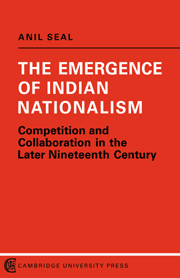Book contents
- Frontmatter
- Contents
- List of Maps and Tables
- Preface
- Abbreviations
- India: British Provinces and Native States
- 1 Political India
- 2 The Political Arithmetic of the Presidencies
- 3 The Rewards of Education
- 4 The Policies of the Rulers
- 5 The Politics of the Associations
- 6 The Politics of Union
- 7 The Muslim Breakaway
- 8 Perspectives
- Appendices
- Glossary
- Biographical Notes
- Bibliography
- Index
6 - The Politics of Union
Published online by Cambridge University Press: 23 November 2009
- Frontmatter
- Contents
- List of Maps and Tables
- Preface
- Abbreviations
- India: British Provinces and Native States
- 1 Political India
- 2 The Political Arithmetic of the Presidencies
- 3 The Rewards of Education
- 4 The Policies of the Rulers
- 5 The Politics of the Associations
- 6 The Politics of Union
- 7 The Muslim Breakaway
- 8 Perspectives
- Appendices
- Glossary
- Biographical Notes
- Bibliography
- Index
Summary
The idea that Indians should take up a common political stance was almost as old as the first stirrings of constitutional politics in India. As soon as the British Indian Association was established in 1851, it made contact with ‘the most influential native gentlemen of Madras and Bombay’, since it knew that petitions to parliament would carry greater weight ‘if they were made simultaneously by the Natives of every part of British India’. Since the three Presidencies would all be affected by the impending changes in the Company's charter, their demands on Westminster should bear ‘the impress of unity’. In the event, the associations of Bombay and Madras decided to act independently. Although Bombay admitted the principle of co-operation and all the petitions to London took the same line, the co-ordinating impulse was still weak. All that united the men of Calcutta, Bombay and Madras was the yoke of British administration. Few of these men knew each other, or the first thing about other parts of India. So although the British Indian Association after 1853 urged ‘the other Societies of the other Presidencies… [to] continue the united agitation’, its larger ambition to represent India came to nothing.
The first Indian organisation to cross provincial boundaries was formed in England by the first generation of Indian students who went there to qualify for the bar or the covenanted civil service. Among these pioneers were four future presidents of the Indian National Congress: Pherozeshah Mehta and Badruddin Tyabji from Bombay, and W. C. Bonnerjee and Manmohan Ghose from Calcutta.
- Type
- Chapter
- Information
- The Emergence of Indian NationalismCompetition and Collaboration in the Later Nineteenth Century, pp. 245 - 297Publisher: Cambridge University PressPrint publication year: 1968

